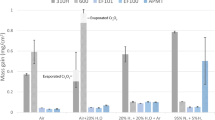Abstract
A study is made on the wettability of sodium chloride and oxygen-free ionic compounds ― fluorides of alkaline-earth elements (CaF, MgF, BaF) ― by molten metals. The metals Cu, Sn, Ag, Au, In, and Ga do not wet these materials (θ ∼ 120-140 deg). The wettability of fluorides by aluminum is somewhat greater (θ ∼ 90-100 deg), in accordance with the greater chemical affinity of aluminum for fluorine. Chemically highly active and aggressive alloys of Ti, Zr, Hf, and V (with concentrations up to 70-80%) which completely wet and destroy known refractory materials (oxide, nitride, carbide, and carbon refractories, etc.) behave anomalously in regard to fluorides ― they do not wet their surface and are inert when in contact with them. This is attributable to the formation of an intermediate gaseous phase (a volatile fluoride) which separates the liquid metal from the solid surface. Effective use can be made of this phenomenon to develop refractories (crucibles, containers, jackets, etc.) for use in the isothermal melting, homogenization, and casting of alloys that contain Ti, Zr, Hf, and V.
Similar content being viewed by others
REFERENCES
Yu. V. Naidich, Contact Phenomena in Metallic Melts [in Russian], Nauk. Dumka, Kiev (1972).
Yu. V. Naidich, “Theoretical principles of wetting, spreading, and impregnation,” in: Physical Materiology in the USSR. History, Current Status, and Future Prospects [in Russian], I. N. Frantsevich and V. I. Trefilov (eds.), Nauk. Dumka, Kiev (1986), pp. 472-486.
K. E. Wicks and F. E. Blom, Thermodynamic Properties of 65 Elements and Their Oxides, Carbides, Nitrides, and Halides [Russian translation], Metallurgiya, Moscow (1965).
N. P. Galkin, Basic Properties of Inorganic Fluorides: Handbook [in Russian], Atomizdat, Moscow (1976).
Y. Naidich, “High strength ceramic brazed joints: Scientific and technological bases,” Ind. Ceram., 19, No. 3, 162-167 (1999).
Y. Naidich, “Ceramics-metal interface: adhesion and wettability process in fundamental and practical aspects: The Sixth Conference and Exhibition of the European Ceramic Society,” British Ceramic Proceedings, 1, No. 60, 315-316 (1999).
M. F. Grigorenko and V. V. Poluyans'ka, “Wetting of alkaline-halogen crystals by low-temperature metallic melts,” Adheziya Rasplavov i Paika Materialov, No. 33, 16 (1997).
Ukrainian Patent No. 96124670, Yu. V. Naidich, V. P. Krasovskii, and O. Yu. Kotlov. Published 12.12.96.
Author information
Authors and Affiliations
Rights and permissions
About this article
Cite this article
Naidich, Y.V. Wettability of Halides with Molten Metals. Physico-Chemical and Practical Aspects. Powder Metallurgy and Metal Ceramics 39, 355–362 (2000). https://doi.org/10.1023/A:1026661422569
Issue Date:
DOI: https://doi.org/10.1023/A:1026661422569




